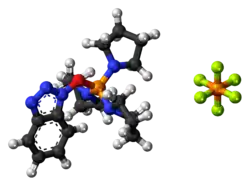PyBOP
 | |
 | |
| Names | |
|---|---|
| IUPAC name
(Benzotriazol-1-yloxy)tripyrrolidinophosphonium hexafluorophosphate
| |
| Other names
PyBOP
| |
| Identifiers | |
3D model (JSmol)
|
|
| ChemSpider | |
| ECHA InfoCard | 100.125.168 |
PubChem CID
|
|
| UNII | |
CompTox Dashboard (EPA)
|
|
| |
| |
| Properties | |
| C18H28F6N6OP2 | |
| Molar mass | 520.401 g·mol−1 |
| Appearance | White crystals |
| Melting point | 150 °C (302 °F; 423 K) |
| Hazards | |
| Occupational safety and health (OHS/OSH): | |
Main hazards
|
Irritant |
| GHS labelling:[1][2] | |

| |
| Warning | |
| H315, H319, H335 | |
| P261, P305+P351+P338 | |
Except where otherwise noted, data are given for materials in their standard state (at 25 °C [77 °F], 100 kPa).
Infobox references
| |
PyBOP (benzotriazol-1-yloxytripyrrolidinophosphonium hexafluorophosphate) is a reagent used to prepare amides from carboxylic acids and amines in the context of peptide synthesis.[3] It can be prepared from 1-hydroxybenzotriazole and a chlorophosphonium reagent under basic conditions.[4] It is a substitute for the BOP reagent that avoids the formation of the carcinogenic waste product HMPA.[5] Thermal hazard analysis by differential scanning calorimetry (DSC) shows PyBOP is potentially explosive.[6]
See also
- BOP reagent
- DEPBT, a related reagent that contains no phosphorus-nitrogen bonds
- HATU
- HBTU
References
- ^ Sigma-Aldrich Co., product no. {{{id}}}.
- ^ GHS: Sigma-Aldrich377848
- ^ Mansour, Tarek S.; Bardhan, Sujata; Wan, Zhao-Kui (2010). "Phosphonium- and Benzotriazolyloxy-Mediated Bond-Forming Reactions and Their Synthetic Applications". Synlett. 2010 (8): 1143–1169. doi:10.1055/s-0029-1219820. ISSN 0936-5214.
- ^ Hoffmann, Frank; Jäger, Lothar; Griehl, Carola (2003). "Synthesis and Chemical Constitution of Diphenoxyphosphoryl Derivatives and Phosphonium Salts as Coupling Reagents for Peptide Segment Condensation". Phosphorus, Sulfur, and Silicon and the Related Elements. 178 (2): 299–309. doi:10.1080/10426500307942. ISSN 1042-6507.
- ^ Coste, J.; Le-Nguyen, D.; Castro, B. (1990). "PyBOP®: A new peptide coupling reagent devoid of toxic by-product". Tetrahedron Letters. 31 (2): 205. doi:10.1016/S0040-4039(00)94371-5.
- ^ Sperry, Jeffrey B.; Minteer, Christopher J.; Tao, JingYa; Johnson, Rebecca; Duzguner, Remzi; Hawksworth, Michael; Oke, Samantha; Richardson, Paul F.; Barnhart, Richard; Bill, David R.; Giusto, Robert A.; Weaver, John D. (2018-09-21). "Thermal Stability Assessment of Peptide Coupling Reagents Commonly Used in Pharmaceutical Manufacturing". Organic Process Research & Development. 22 (9): 1262–1275. doi:10.1021/acs.oprd.8b00193. ISSN 1083-6160.